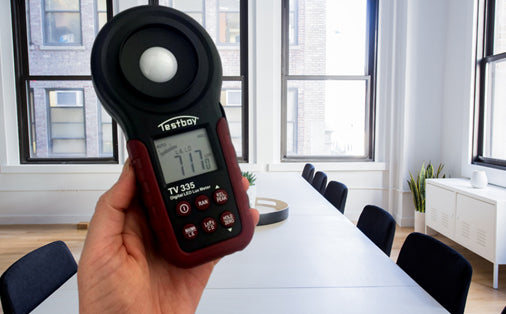Light Meters are valuable tools that measure light intensity in lux output – but what are they used for? This article details some of the most popular applications for light meters.
What Is a Light Meter?
A light meter is a highly sensitive piece of equipment designed to measure the amount of light either falling on a surface (incident light) or reflected from a surface (reflective light).
What Is a Light Meter Used For?
There is a wide range of uses of light meters across many applications and industries. Below we have listed four key examples:
- Occupational Health and Safety (OH&S): One of the most common uses for light meters is OH&S. Lighting in general work areas must be adequate for tasks to be performed safely; this means light must not be too bright and not too dim. In Australia, the recommended lux value for general working areas is 160. Although some areas require more lighting, office area lighting should be within 320-400 lux. Access areas, stairs, specific areas and emergency lighting also have minimum recommended values for OH&S.
- Public Spaces: Public areas such as parks, car parks and streets must be illuminated adequately to create a safe environment, and well-lit spaces can also act as a crime and vandalism deterrent.
- Construction, Engineering and Architecture: Light meters help builders and architects decide on window or skylight placement when constructing or remodelling. Light meters are a helpful tool when selecting suitable lighting fixtures for finished homes.
- Photography: Photographers use incident or reflective light measurements gathered by a light meter to select the most beneficial f/stop and shutter speed on their camera based on the subject and current lighting conditions.
Light Meter Examples
Our scientists have assembled a cross-section of product examples suitable for various applications to highlight the extensive range of light meters on offer.

Digital Light Meter
|

Professional Digital Light Meter
|

Testboy TV 335 Digital LED/Lux Meter
|

Testo 440 Lux Kit
|
Conclusion: What Is a Light Meter Used For?
Light meters measure light levels for applications in industries like; health and safety, ensuring adequate lighting in workspaces, making lighting decisions for building design and construction, and photography to get the perfect shot.
Want more information on any of the products listed above? Need assistance or advice to help you choose the best light meter for your application? Speak with an Instrument Choice Scientist! Call 1300 737 871 or email customer-service@instrumentchoice.com.au.

